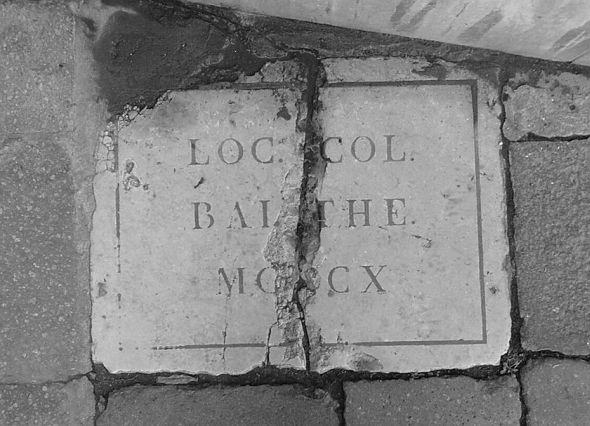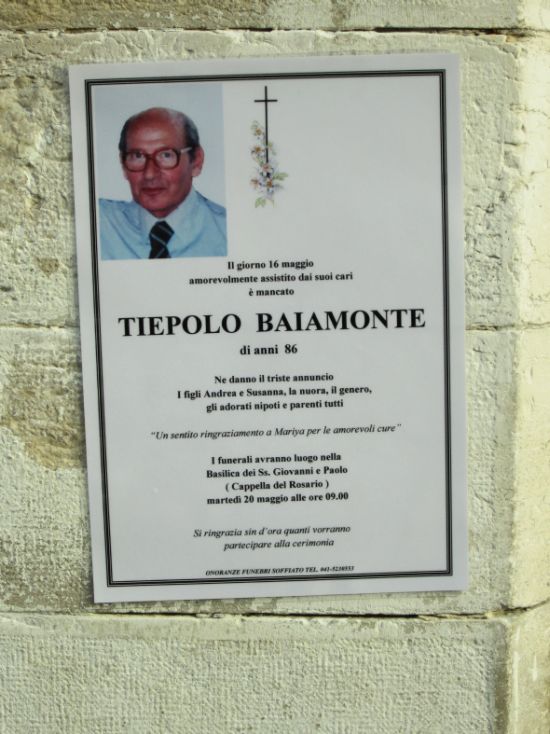Walking home the other day, I cast my eye, as usual, on the building corner which Lino refers to as “The Wailing Wall.” Meaning no disrespect to the original place of that name, our little angle is the perfect spot to tape up death notices. I’ve mentioned on other occasions that the cost to publish such a notice in the Gazzettino is totally fantastical, so these rectangles of plastic are extremely useful in keeping people up to date on for whom the bell is tolling.
But I don’t usually expect to see names I recognize, mainly because the number of people I know who might be likely to demise is very limited. And although some surnames are a little unusual, there are very few which hurl one back 700 years into one of the most complicated and desperate conspiracies ever formed to attempt the overthrow of the Venetian Republic.
So I was unprepared to see a new notice stuck on the wall, complete with photo of the deceased, announcing the death of Baiamonte Tiepolo.
This name may not connote much to you, but anyone who has skimmed Venetian history knows it as the name of one of the most audacious revolutionaries who ever tried to scuttle somebody’s government.
It was like seeing a notice for some innocuous little person who just happened to be named Benedict Arnold, or Oliver Cromwell, or Ernesto Guevara, or Gregory Rasputin.
As for someone bearing the name of a renowned Venetian noble family, this isn’t quite so startling. I interviewed a descendant of doge Jacopo Tiepolo some years ago, and I know that there are Grimanis and Zorzis and Da Mosto’s still roaming the city. I have also met a young woman carrying forward the storied name of Bragadin.
But it’s one thing to bear the last name; if you were a Bragadin, I think it would be cruel to name your son Marcantonio. The name is certainly worthy of remembrance, but the boy’s life would be hell. There are only so many witty remarks you can make to someone whose forebear was flayed alive after an epic siege that lasted almost a year, and the lad would have to hear all of them.
On the same note, the Venice phone book lists two men named Marco Polo. They must have been doomed to a life of a steady drizzle of really funny remarks. “Hey, Marco — back so soon?” “Give my regards to the Khan, next time you see him.” “Did you really invent pasta?” And so on.
For the late Baiamonte, the drollery would have had to be more erudite, and I won’t risk any here because life is short, and by the time one (that is, me) has related as much as possible of his ancestor’s spectacular, if also scurrilous, story, the potential for humor would have dried up and blown away in the wind. But I feel safe in saying that, thanks to his namesake and his cohorts, the year 1310 stands out in Venetian history as much as 1492 or 1776 stands out in the American annals.
Here is the drastically condensed version of his story. The plot was foiled, he was exiled for four years, and his palace was torn down. He spent those years traveling, visiting Venice’s enemies (Padova, Treviso, Rovigo, and some very powerful families therein) doing everything conceivable to convince them to join him in another conspiracy. He just wouldn’t give up.
Not amused, Venice changed the sentence to perpetual exile. He wandered around Dalmatia seeking new collaborators. He was imprisoned. He escaped. The Venetian government forbade anybody to have anything to do with him. Finally, in 1329, the Council of Ten decreed that he had to be eliminated, by any means.
The details of Baiamonte’s death are uncertain, which is not surprising when a person has to be eliminated. (The “Caught a cold and stopped breathing” explanation has often been sufficient.) As for location, at least one historian states that he was in Croatia, staying with relatives, when his last day came and went.
For the Tiepolos of Lower Castello, maybe it was a point of pride to name their son Baiamonte. It couldn’t have been inadvertent. I can’t imagine somebody saying “Heavenly days, it never crossed my mind that somebody would think of the old subversive of blackened fame.”
I notice, though, that he named his son Andrea. Maybe he had had enough.



4 Comments
I taught a Robin Hood. He used his other name, Peter.
I can totally understand that. Gad.
In your splendid blog: “Eventually the column was broken up.” Well, knocked about a bit, but not destroyed. The novelist Michelle Lovric tracked it down to a storeroom in the Correr and has photos to prove it. She launched a Venice in Peril campaign, so far unsuccessful, to have it exhibited. And she gave me and my wife, Gillian Crampton Smith, a lively painting of it because we live behind the only door in Calle Bajamonte Tiepolo. The painting is by Kaitlin Zorah McDonough (2009). Michelle mentions it in:
http://awfullybigblogadventure.blogspot.it/2010/02/stranger-than-fiction-michelle-lovric.html